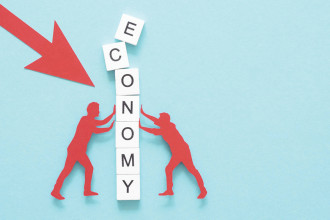
Just a few decades ago, the idea of an electric vehicle cruising the streets of Nepal seemed a distant prospect – an indulgence of futuristic cities far removed from Nepal’s realities. Fast forward to 2025, and electric vehicles (EVs) are no longer rare sightings but an increasingly common presence on Nepal’s roads. In a remarkable shift, 70% of all new passenger vehicle imports into Nepal during 2024 have been electric, outpacing the global average of 30%.
Behind this momentum lies a confluence of smart policy, geographic advantage and changing consumer behaviour. Nestled between India and China – two of the world’s largest EV manufacturers and battery innovators – Nepal is strategically positioned to tap into supply chains and benefit from technological advancements. The government’s progressive tax policy, slashing EV import duties to as low as 15% compared to 80% for combustion engine vehicles, has further catalysed this transformation.
Financial institutions have played their part too, previously offering up to 90% financing for EV purchases, making them far more accessible to the middle class.
But as Nepal accelerates down this electric highway, warning lights are beginning to flash on the dashboard. The very policies and mechanisms that fuelled this boom are now being revised, and the effects are rippling through the market. A mid-term review by Nepal Rastra Bank has drastically changed the financial landscape: maximum bank financing for EVs has been reduced from 90% to 60%, while combustion vehicles now enjoy the same 60% threshold, nullifying one of the core advantages that EVs previously held.
To delve deeper into these pressing questions, Business 360 spoke to some of Nepal’s EV leaders for their insights.

Sunil B Chhetri, General Manager at Paramount Motors; Rupesh Sharma Bhatta, CEO of MAW Vriddhi Autocorp (Changan Nepal); Rajan Babu Shrestha, CEO of Sipradi Companies; and Jai Golchha, Director of Shangrila Motors offer perspectives on whether Nepal’s electric vehicle boom is built to last or if it is veering into uncertain territory.
Can Nepal afford to promote green mobility while frequently revising rules and guidelines on EVs?
Sunil B Chhetri: Definitely not. Frequent tax and financing revisions are creating confusion among buyers and importers and have a severe impact on market confidence. We have already seen the tax changed four times in the last three years, along with a change in bank financing policy for EVs. We are now suffering the impact of a recent change in bank financing policy, which has resulted in a drop in sales by 40%. We, as importers and investors, are discouraged by abrupt policy changes and they make private operators think twice about investment in charging network, battery recycling facilities, which are key components of growing EV ecosystem. We strongly suggest the government not to prioritise short-term revenue over long-term goals set by the government only for green mobility and climate goals.
Rupesh Sharma Bhatta: Frequent policy changes create uncertainty, discouraging both investors and public adoption of electric vehicles due to diminished confidence. Green mobility can only be effectively promoted through policies that are stable, clear and forward-looking. Ensuring long-term momentum requires unwavering policy consistency.
Rajan Babu Shrestha: I firmly believe that Nepal can and must promote green mobility but to do so effectively, policy consistency is critical. Frequent revisions to EV-related rules, such as customs duty changes, road tax adjustments, and vague subsidy structures, erode trust and confidence among consumers, investors and automakers.
These changes often come without adequate consultation or long-term vision, creating uncertainty in pricing and planning. That said, green mobility is not a luxury for Nepal, it is a necessity. However, inconsistent policies such as the reversal of tax benefits or unclear EV infrastructure regulations deter the very momentum we are trying to build.
What Nepal needs now is a stable, multi-year EV roadmap, jointly developed with private sector stakeholders. This roadmap should outline:
- Stable fiscal policies (import duties, VAT, and subsidies)
- Charging infrastructure regulations
- Incentives for local assembly and innovation
- Support for fleet electrification and public transport
Nepal can afford to promote green mobility but it cannot afford policy unpredictability. Predictable, forward-looking governance is the foundation on which a successful EV ecosystem will be built.
Jai Golchha: As long as the rules and guidelines are tweaked in minor ways to help the government achieve certain goals, it is completely fine. But changing the rules to an extent where purchasing decisions can change to combustion engine driven vehicles is not the way to go.

We need to work on a stable EV-friendly policy which will help give confidence to importers and consumers. This will also help importers and investors to have a long-term plan on building a robust EV ecosystem and investment in charging infrastructure, battery recycling, technical training and aftersales.
– Sunil B Chhetri
General Manager at Paramount Motors
What lessons can Nepal learn from countries with consistent EV policies and how can they be applied in our federal governance system?
Sunil B Chhetri: For EV adoption and infrastructure, we can look at Norway and China which have developed a sustainable EV ecosystem in leaps and bounds. We can learn from Norway on EV incentive stability for a long time which has helped them align with their environmental goals, being one of the largest clean energies (hydro) producers. From China, we can learn about EV infrastructure scaling for mass transportation, from passenger cars to buses to metro to high-speed trains and how it has benefitted them economically and environmentally. Since we are at an early stage of the federal governance system, we need to harmonise the policy to be consistent and create a better platform for transformation in the environmental and economic aspects.
Rupesh Sharma Bhatta: China and Norway have taken leading roles in promoting electric vehicle adoption through various policies. China focuses on subsidies, infrastructure development, and research and development, while Norway prioritises tax incentives and the expansion of charging infrastructure. These countries demonstrate the importance of long-term policy commitments, fiscal incentives and infrastructure investments in driving EV adoption. Nepal can adopt similar strategies by developing a federal EV roadmap with clear targets, ensuring policy alignment between provincial and central governments, and establishing autonomous bodies that remain resilient to political fluctuations.
Rajan Babu Shrestha: Nepal can learn critical lessons from countries and regions such as Norway, China and Indian states like Maharashtra that have successfully promoted electric mobility through consistent and stable EV policies. These lessons can be tailored to work within Nepal’s federal governance framework.
Countries like Norway committed to EVs over a decade ago, maintaining predictable incentives (e.g., tax exemptions, toll waivers, parking benefits). This long-term commitment has boosted consumer and investor confidence. Similarly, Nepal should avoid yearly tax fluctuations and instead develop a 5–10-year National EV Roadmap, agreed upon by both federal and provincial governments, outlining incentives encouraging EV adoption, EV infrastructure goals and public fleet electrification targets.
In China and recently in India – Maharashtra, generous subsidies, tax exemptions reduced the price gap between EVs and ICE vehicles, accelerating adoption. Their policy support was backed by a roadmap to instal thousands of EV charging stations across highways and cities.
In Nepal, it is high time to establish a national charging infrastructure blueprint, identifying high-priority corridors (e.g., Kathmandu–Pokhara, East-West Highway). Here, government can encourage PPP models at the provincial level to share the vision.
Also, these countries with high EV adoption align EV promotion with local resources. Much like Nepal, Norway is rich in clean hydropower, and their EV strategies are tailored to this, their local strengths.
Jai Golchha: Consistent EV policies allow for the rapid expansion of the entire ecosystem around the vehicles. If importers and sellers do not have to be worried about losing significant market share based on rule changes, they will be allowed to draw up and execute plans with long-term horizons. This will allow the focus to shift from annual sales and service targets to more comprehensive business planning.

Frequent policy changes create uncertainty, discouraging both investors and public adoption of electric vehicles due to diminished confidence. Green mobility can only be effectively promoted through policies that are stable, clear and forward-looking.
– Rupesh Sharma Bhatta
CEO of MAW Vriddhi Autocorp (Changan Nepal)
With frequent power outages becoming a growing concern in many parts of the world, including our own country, can our current electricity infrastructure be trusted to support the widespread adoption of electric vehicles?
Sunil B Chhetri: There is still concern over the current electricity infrastructure by Nepal Electricity Authority (NEA) due to irregular voltage fluctuation, which damages the DC chargers, resulting in further investment in repair and purchase of additional voltage stabilisers. We can say we trust the infrastructure, as we can see NEA has been working on upgrading its transmission and grid lines in many parts of Nepal to support the massive hydro energy production expected in the coming years.
Rupesh Sharma Bhatta: While Nepal’s hydropower capacity is expanding, the existing grid infrastructure remains outdated and unevenly distributed. Without significant upgrades to transmission networks, energy storage and smart grid systems, widespread EV adoption could place considerable strain on the system. To support the transition to electric mobility, Nepal must modernise its grid with smart technologies, invest in storage solutions to manage peak demand, promote decentralised energy options such as solar-powered charging stations, and improve the reliability and reach of the national grid, particularly in rural areas.
Rajan Babu Shrestha: That is a very timely and important question. Nepal’s push toward electric mobility is smart, especially considering our hydropower-dominated energy mix, but we must address the reliability and resilience of our electricity infrastructure. While we produce clean energy, distribution and grid stability remain a challenge.
Nepal’s electricity generation potential is strong but infrastructure readiness is not yet aligned with the EV growth curve. If we do not invest in grid reliability now, we risk undermining the very EV revolution we are promoting.
Jai Golchha: Since the country is observing rapid growth in the hydropower sector, I am confident the country’s infrastructure can support the widespread adoption of electric vehicles. The problem only arises during the dry season because of the inability to store power. If we can effectively sell excess power during peak seasons and effectively use that budget to purchase power during low fall seasons, we can easily cater to the rising demand for power to charge EVs.

Nepal can afford to promote green mobility but it cannot afford policy unpredictability. Predictable, forward-looking governance is the foundation on which a successful EV ecosystem will be built.
– Rajan Babu Shrestha
CEO of Sipradi Companies
How can the private sector be incentivised to invest in charging infrastructure and EV servicing ecosystems?
Sunil B Chhetri: We do not see any new incentive programme now or in future from the government. Having said that, we see NEA offering a lower unit rate at night for a dedicated line. There was a discussion of vehicle-to-grid (V2G) from the government but systems are not in place yet. However, now importers are working with small business owners (especially hotels) along the major highways on a hybrid model for charging infrastructure development. This has offered a unique business model to small-time restaurants, hotel owners to set up DC charging stations, which has helped generate revenue from EV charging as well as food or room sales. We can see this model being very successful and can see lots of DC charging stations set up in restaurants and hotels along major highways. This has helped in building confidence in customers for charging anxiety during highway travel and improving the EV ecosystem as a key pillar.
Rupesh Sharma Bhatta: Clear, long-term policies supported by fiscal incentives – such as tax breaks, low-interest loans, and subsidies – can significantly encourage private investment in the EV sector. Public-private partnerships, land leasing for charging infrastructure and a streamlined licensing process can further accelerate the development and deployment of EV-related services.
Rajan Babu Shrestha: Incentivising the private sector to invest in EV charging infrastructure and servicing ecosystems is crucial for scaling EV adoption in Nepal, especially as the government alone cannot meet the demand and a private company without a long-term EV policy is not confident enough for a huge investment. Therefore, a well-structured incentive framework can unlock capital, accelerate innovation, and ensure nationwide coverage. While the government sets the policy direction, the scale, speed and innovation required will only come from private enterprises with the right incentives in place.
Again, coming back to Maharashtra’s EV policy, they have:
- Private firms get capital incentives for the charging infrastructure
- They are allowed to earn carbon credits
- Cities allocate urban land to startups for charging under PPPs
And these incentives can go a long way. The private sector is ready to invest but needs predictable returns, policy clarity, and easier access to capital. A well-structured incentive package, aligned with Nepal’s federal governance, will unlock the entrepreneurial momentum needed to scale EV charging and service ecosystems.
Jai Golchha: The desire to establish a strong brand and achieve customer satisfaction is incentive enough for the private sector to invest in charging infrastructure and ecosystems. Considering the size of our country, I do not think we are too far from achieving a satisfactory level of chargers in the country.

If importers and sellers do not have to be worried about losing significant market share based on rule changes, they will be allowed to draw up and execute plans with long-term horizons. This will allow the focus to shift from annual sales and service targets to more comprehensive business planning.
– Jai Golchha
Director of Shangrila Motors
What steps can Nepal take to position itself as a leader in clean mobility?
Sunil B Chhetri: We have made significant strides in EV adoption over the last couple of years. Firstly, we need to work on a stable EV-friendly policy which will help give confidence to importers and consumers. This will also help importers and investors to have a long-term plan on building a robust EV ecosystem and investment in charging infrastructure, battery recycling, technical training and aftersales. Secondly, we need to focus on the electrification of mass transportation. For this, the government needs to work on incentivising the import and use of EV buses, mini buses and trucks, which will help reduce the use of diesel and ultimately reduce the import of diesel, which is one of the major pies in total fossil fuel imports.
With an abundance of clean hydro energy, we can also use the international funds available such as green funds from different international agencies like GIZ, ADB, to help accelerate the growth of EV adoption and ecosystem for Nepal to position itself as a leader in clean mobility.
Rupesh Sharma Bhatta: Nepal holds a strategic advantage with its abundant hydropower resources and a relatively manageable vehicle market size. To become a regional leader in clean mobility, Nepal should develop a comprehensive EV policy that includes stable and long-term incentives. Key actions include encouraging local EV assembly and innovation, investing in renewable energy infrastructure and grid resilience, and launching public awareness campaigns to highlight the environmental and economic benefits of electric mobility.
Rajan Babu Shrestha: To position itself as a regional leader in clean mobility, Nepal must capitalise on its unique strengths – abundant hydropower, compact geography, and rising EV adoption momentum while addressing existing infrastructural and policy gaps with vision and coordination.
Nepal has the natural resources, political will and growing consumer appetite to lead the region in clean mobility. We can see the acceptance of EVs over the past years. But this leadership will only materialise through strategic coordination, long-term policy stability, and bold public-private partnerships.
Jai Golchha: In terms of the private sector, as long as the import taxes do not fluctuate too much, I think Nepal is already on its way to becoming a leader in clean mobility. If we can emulate this for public transport by making EVs cheaper than regular ICE public transport for the end customer, then this can be achieved in the entire clean mobility sector across the board.






